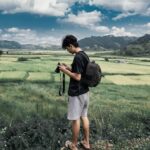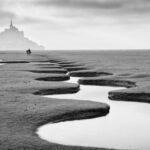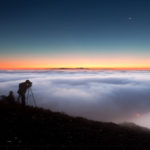This is an article targeted toward beginners just starting out. It’s not very technical information, rather it focuses on some simple yet important tips that beginners should consider.
With that in mind, I would strongly advise you to read through the whole article, even if you’re an average amateur, just to freshen up on the mental aspect of photography. I’ve never written an article on my way of thinking when taking pictures, but I think it’s cool because it’s not like your everyday photography tips article. So read on for a few secrets, along with a few photos, of course.
Learn to See Creatively
The best way to learn to see creatively is to take more photos. The reason being is because the more pictures you take and the more time you spend on your photography, the more you’ll begin to see things you would normally never see. The eyes of a true photographer, or artist, sees shapes, patterns, light, and color when walking down an ally or across a street. For example, let’s take this photo of a railroad track I took in Downtown Royal Oak, Michigan:

Railroad Track in Downtown Royal Oak, Michigan by Tim Kainu
I saw a good photo because of 1) the light reflecting off the metal, 2) the contrasts in color between the wood and metal, and 3) the strong diagonal lines of the track leading from edge-to-edge. Before I learned how to see creatively, I’d probably walked over that railroad track a million times and not once had I seen it the way I do now. All these things added together create a great picture for the eye. That’s good and all, but the photo is missing a strong message. It doesn’t emit a strong enough feeling/emotion when one views the photo.
Feel the Moment
If the following makes any sense what-so-ever, it’s that I believe everyone has the ability to see creatively in their own personal way. To see creatively is, in my opinion, to set your mind free and get in-tune with your feelings. These feelings are what drive powerful photographs. And if you can get your brain, eyes, and camera to link with your feelings then you’ve just opened up a door that has the potential for you to become a great photographer.
You want people to feel your photos and get a strong emotional reaction, because it’s all about the feeling, the impact, and the structural composition of a photo. There are just a few key steps to improve the feel and impact of your photos, making them into memorable masterpieces. It’s certainly not as easy as you’d think and definitely not something you can learn in a few hours or a few days. It may take weeks, months, and sometimes years. It’s all up to you and how much time and devotion you spend taking photos and learning photography. When you’re out shooting and see something you want to take a picture of, stop and ask yourself these three questions:
- Why do I want to take this photo?
- What is the main message of the photo?
- How am I going to take the picture effectively?
Keep asking yourself these three questions before you press the shutter and—I promise you—there will be an improvement in your photos. Let me explain the questions in more detail:
The question “why do I want to take this photo” forces you to explain your feelings. You did, after all, stop to take the photo because you “felt” it could be a good photo. But why? Was it because the light was good? Was there something extraordinary happening? The more you ask yourself why and the more you answer why, the more you’ll start to feel the moment and start seeing creatively. Remember, it’s all about feeling and communicating that feeling to the viewer.
So now that you know why you want to take the photo, you have to ask yourself, “What is the main message of the photo?” This question will better refine the first question, helping you define the actual subject whether it be exquisite shapes and colors or a person whose face tells a story of a life-long struggling journey. Whatever it is, it prepares you for the next question: “How am I going to take the picture effectively?”
Well, you can start by thinking of the first two questions and what their answers were. Here, I’ll use an example of a shot I took in Port Huron, Michigan:
Say you’re sitting in a car at a red light and see a man starting to cross the street. You feel it can make a good photo, so you ask yourself “why” and answer “because the sky is blazing red and the timing just right.” So you quickly ask yourself the next question, “what is the main message of the photo” and answer “to get the feeling and mood of an urban sunset.” Next you swiftly take out the camera (shame on you not having it out already) and ask yourself the final question; “How am I going to take the picture effectively?”
You struggle at first, then you realize that timing is everything. So you quickly compose the shot, frantically making sure the buildings are lined up roughly using the rule of thirds and wait until the man crossing the street is right in the middle of the blinding sun, creating an awesome editorial like silhouette. Here’s the result:

Sitting in a car at a red light and see a man starting to cross the street. You feel it can make a good photo…
These three questions will become second nature to you, and soon you’ll find yourself asking and answering these questions subconsciously. Just remember once again, that communicating your feelings through your photographs by using your creative eye and brain—all linked together—will make for amazing, memorable photos.
Study Amazing Photos and Books
Granted, I’m not an amazing photographer by any sorts—just an average amateur, but I believe that if you want to take good photos, you can. And you can do so without going to school. I am self taught in pretty much everything I do, photography being my main passion. A big influence for me are amazing photos. You can learn a lot by studying them and figuring out what makes it an awesome photo just by asking yourself the same three why, what, and how questions mentioned above. I sometimes spend hours just analyzing photos, both to enjoy and also to figure out the ingredients of making it a memorable photo. Go to sites like the Flickr, Photo.net, 500px, and 1X because not only do they have photos, they have amazing photos. Look at the photos that interest you and ask yourself why they interest you. Just start studying them, and read the peoples reactions to the photos. Learn everything there is to know.
If you like to learn through books, I’d suggest picking up at least three out of the four books mentioned here because all of these books have made a significant impact on my photography:
- The Photographer’s Eye: Composition and Design for Better Digital Photos by Michael Freeman
- Understanding Exposure, 3rd Edition: How to Shoot Great Photographs with Any Camera by Bryan Peterson
- The Hot Shoe Diaries: Big Light from Small Flashes by Joe McNally
- The Camera (Ansel Adams Photography, Book 1) by Ansel Adams and Robert Baker
Did you notice that I picked four books on four completely different subjects? That’s because with these four books you can learn everything from off-camera lighting and composition, to Photoshop and exposure. These books combined together are just awesome to read and study, and because they’re written by very well known photographers, you know there’s good info to gather inside.
Get Constructive Criticism
Improving your photography and taking good photos means you have to get advice from the pros, because they’ve been where you’re at and know the good and bad and the right and wrong in photography. I personally have never talked to a real “professional” photographer face-to-face. I’ve only chatted with pros through the use of web forums and email. I’d suggest, if you can, to meet a few pros and join them in a few gigs or whatnot, which is actually something on my to-do list because working with an actual pro will give you hands-on experience and get real feedback, real constructive criticism—unlike the kind your family and friends give you.
I’d suggest you sign up to one or all of these critique websites because they, too, can give you honest but sometimes blunt, constructive criticism:
And last but not least my favorite and by far the best of them all, http://1x.com. You have to sign up to see and use their critique system, but it’s totally worth it.
What you do is you sign up to one or all of the critique websites, and post a photo that you want to receive some feedback on. Most of the time these sites require you to give feedback on at least one photo before posting your own. This makes the community balanced, so everyone doesn’t just keep posting pictures for critique and never give out any critiques themselves.
In addition to critique websites, there are a few photography blogs that I love, also. The first being the well-known blog authored by David Hobby called Strobist. His blog is mainly about off-camera lighting. I have to mention him just for the sake of mentioning him, Ken Rockwell. He’s pretty much a Nikon fanatic that talks and jokes a lot about a wealth of different subjects. He also has a lot of great information on Nikon camera gear. Joshua Hoffine is probably one of my favorite photographers because he sets up his shots as if they’re movies. He also has a great blog so I would recommend that you follow him just so you can see his latest amazing work and how he creates them. Also some great tips at PCMag: photography tips for beginners.
And now for the no brainer…
Keep Pressing That Shutter!
Practice makes perfect and taking photos is no exception. If you want to become the next best photographer in town, or in the world (hey, it’s possible!) you have to get out and start shooting more. And for those who log in 60 plus hours of work a week and still strive to be a great photographer, you have to find time to get out and shoot. It’s tough, I know. I work around 50 hours a week at my retail job here in Berkley, Michigan and know first-hand how hard it is finding time to take photos.
If you want to get better, you have to dedicate time to shoot pictures. When I first got into photography I didn’t spend more than a few hours a month with my camera. And it showed. My photos looked the same as they did when I first started. Something needed to be done, so I got into the habit of spending a few hours every week working on my technique. That eventually developed into a few hours every other day learning how to take photos. Soon I’d find myself spending hours upon hours every single day taking photos and learning, that I think my head literally got a few centimeters bigger from all the information I had gathered!
Final Words
If there’s one thing that I’ve found out over the last year while trying to become a better photographer, it’s that attitude has everything to do with photos. Most of this article has nothing to do with an actual photography “technique” if you will, because I feel that if you’re told to take photos a certain way you’re constricted within a set of silly rules, and you’ll never be able to explore photography with your own feelings. Anyways, I hope I brought up some good points—ones that you will take into action soon. Because if you do, I know you’ll soon discover that there is a great photographer within you. You just gotta have the motivation to continue and have the right attitude.
About the Author:
Tim Kainu is a photographer, digital artist and graphic designer currently based in the little town of Berkley, Michigan. He classifies himself as an unconventional, non-traditional photographer where digital is his medium of choice. He likes to create images that would be impossible to create without the use of digital manipulation.
Like This Article?
Don't Miss The Next One!
Join over 100,000 photographers of all experience levels who receive our free photography tips and articles to stay current:






Thank you :) I LOVE this article. I also love your pictures thanks SOO much for sharing
Hey Spookus,
Here is the link to the other book you asked about – http://www.amazon.com/Scott-Kelbys-7-Point-System-Photoshop/ – I’m glad you learned a thing or two about my article. It makes me happy to hear that =]
Thanks again, and keep on shooting,
Tim
Thanks Tim for the response. I look forward to keeping up on your blog!!!
Thank you Tim for the wonderful post and I learned a lot. Quick question – I get a lot out of reading and bookmarked all the books mentioned. You said there were 5 books, but I only see 4:-( (Study Amazing Photos and Books) Can you tell me what the last book was? Thanks!!!